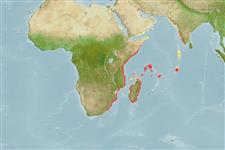Teleostei (teleosts) >
Ovalentaria/misc (Various families in series Ovalentaria) >
Pseudochromidae (Dottybacks) > Pseudochrominae
Etymology: Pseudochromis: Greek, pseudes = false + Greek, chromis = a fish, perhaps a perch (Ref. 45335).
More on author: Regan.
Environment: milieu / climate zone / depth range / distribution range
Ecology
Marine; benthopelagic; depth range 5 - 25 m (Ref. 5471). Subtropical
Western Indian Ocean: Durban, South Africa to Kifuki Island, Mozambique; Kenya (2°S) and Madagascar.
Size / Weight / Age
Maturity: Lm ? range ? - ? cm
Max length : 9.0 cm SL male/unsexed; (Ref. 11228)
Found near large boulders or lying still against greenish weed.
Life cycle and mating behavior
Maturity | Reproduction | Spawning | Eggs | Fecundity | Larvae
Smith, M.M., 1986. Pseudochromidae. p. 539-541. In M.M. Smith and P.C. Heemstra (eds.) Smiths' sea fishes. Springer-Verlag, Berlin. (Ref. 5471)
IUCN Red List Status (Ref. 130435: Version 2025-1)
Threat to humans
Harmless
Human uses
Tools
Special reports
Download XML
Internet sources
Estimates based on models
Preferred temperature (Ref.
123201): 24.6 - 28.8, mean 27 °C (based on 264 cells).
Phylogenetic diversity index (Ref.
82804): PD
50 = 0.5000 [Uniqueness, from 0.5 = low to 2.0 = high].
Bayesian length-weight: a=0.01148 (0.00474 - 0.02781), b=2.95 (2.74 - 3.16), in cm total length, based on LWR estimates for this (Sub)family-body shape (Ref.
93245).
Trophic level (Ref.
69278): 3.6 ±0.5 se; based on size and trophs of closest relatives
Resilience (Ref.
120179): High, minimum population doubling time less than 15 months (Preliminary K or Fecundity.).
Fishing Vulnerability (Ref.
59153): Low vulnerability (10 of 100).
🛈
